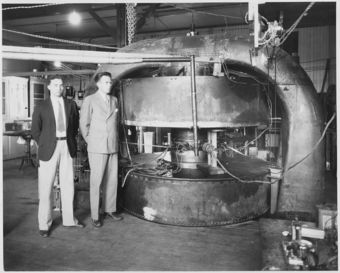Category:Nuclear and plasma sciences
Background
Nuclear and plasma sciences deal with the study of atomic particles, including the state of plasma where a certain number of particles are ionized. While early atomic theory dates back to the late 18th century with the work of Antoine Lavoisier and Joseph Louis Proust, subatomic particles, specifically the electron, was discovered in 1897 by J.J. Thomson. Ernest Rutherford's model in 1909 gave a further understanding of nuclei and the Bohr model was developed in 1913, providing for a brief explanation of quantum mechanics. Rutherford would later discover the proton in 1918 and the proton-neutron model was proposed by Dmitry Ivanenko in 1932. Credit for the discovery of the neutron was given to James Chadwick, who won the Nobel Prize for his discovery in 1935.
Further understanding of atomic structure led to particle accelerators in the form of the cyclotron (1932) and experiments with nuclear fission and fusion during the Manhattan Project resulting in the atomic bomb. More powerful particle accelerators called synchrotrons would be developed in the 1950s with the Bevatron and the Cosmotron. Synchrotrons are still used today, the largest of which being the Large Hadron Collider, built by CERN in 2009.
The IEEE represents its interest in these sciences with the IEEE Nuclear and Plasma Sciences Society, which publishes the Transactions on Nuclear Science, Transactions on Plasma Science and the Transactions on Medical Imaging.
Subcategories
- Colliding beam devices - Particle accelerators which involve directed beams of particles
- Electron emission - A type of beta decay in which an electron is emitted
- Fusion power generation - Generation of nuclear power using fusion
- Fusion reactors - Nuclear reactors which generate power by fusion
- Gamma rays - Electromagnetic radiation high frequency and very short wavelength
- Gas discharge devices - Devices which aid in the protection of data lines which may result from transient surgers
- High energy physics instrumentation computing - Computing used in high energy physics instrumentation
- Ion beam applications - Applications of ion beams, including their implementation
- Ion emission - Emission of ions, usually induced by fields
- Nuclear electronics - Electronics used in nuclear and particle physics
- Nuclear medicine - The branch of medicine which uses radioactive decay for imaging, diagnosis and treatment
- Nuclear physics - The branch of physics dedicated to the study of the atom
- Particle accelerators - Devices which accelerate charged particles to high speeds
- Particles - Subatomic particles including neutrons, protons, electrons, positrons and photons
- Plasmas - Topics dealing with plasma, the state of matter similar to a gas where particles are ionized
- Radiation - The process in which particles or waves travel through a medium
- Reactor instrumentation - Instrumentation used in reactors
- Scintillation counters - An instrument used to measure ionizing radiation
Subcategories
This category has the following 18 subcategories, out of 18 total.
Pages in category "Nuclear and plasma sciences"
The following 134 pages are in this category, out of 134 total.
A
B
C
- Oral-History:James Thomas Cain
- George Carruthers
- Cell Phone Antenna Links
- Milestones:CERN Experimental Instrumentation, 1968
- James Chadwick
- Oral-History:Milton Chaffee
- Chicago Pile-1
- Oral-History:Marvin Chodorow
- Henry R. Chope
- First-Hand:Spanning the Cold War Nuclear Weapons Era: 1956-58 to 1994-2001
- Cosmic Background Radiation
- Louis Costrell
- Marie Curie
S
F
G
H
L
M
N
P
R
T
V
Media in category "Nuclear and plasma sciences"
This category contains only the following file.
- CL9-vacuum.jpg 2,000 × 2,966; 1.25 MB

